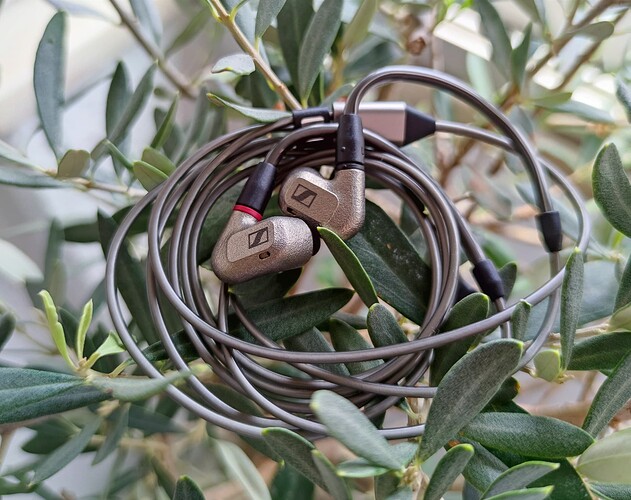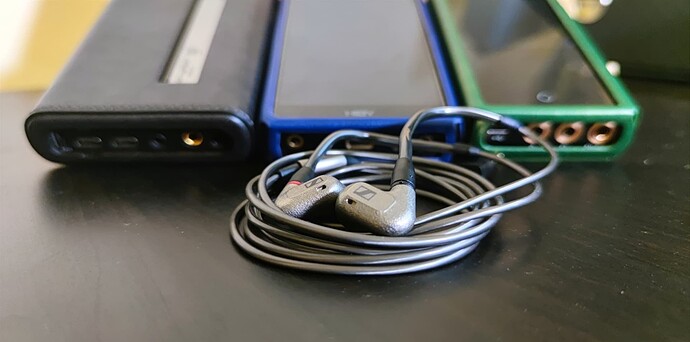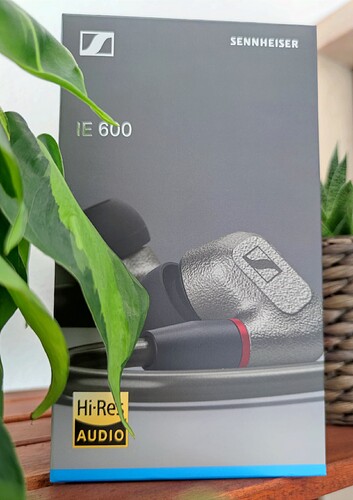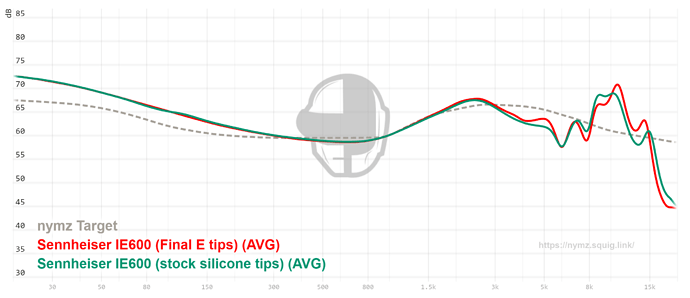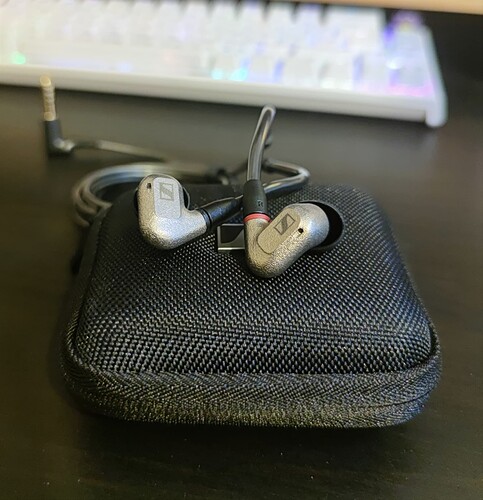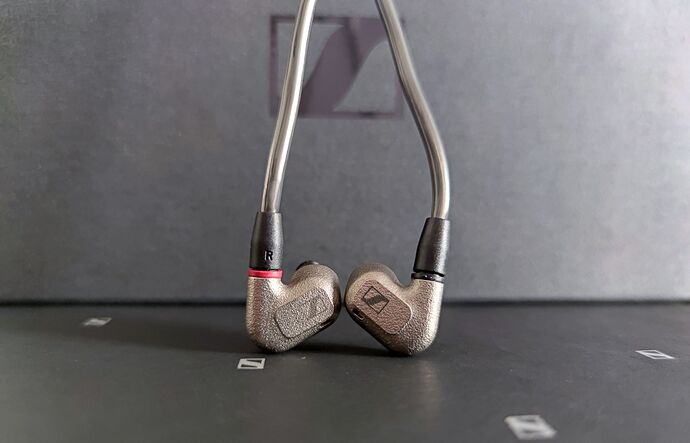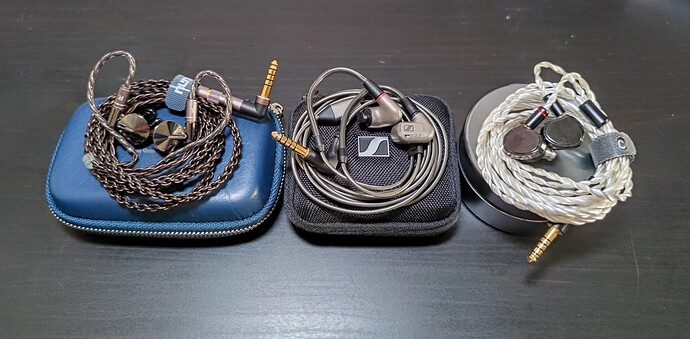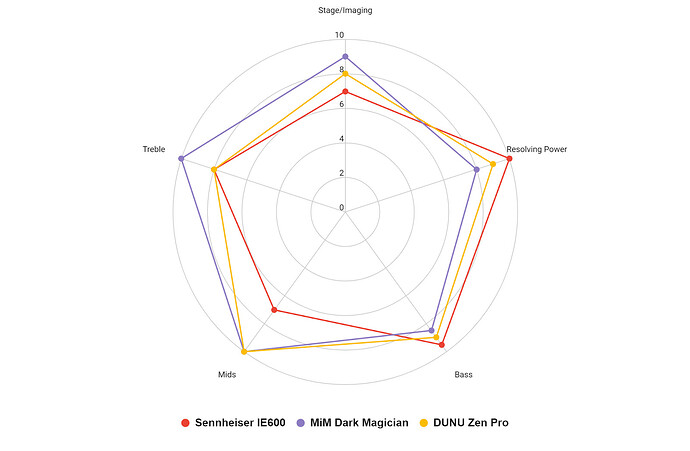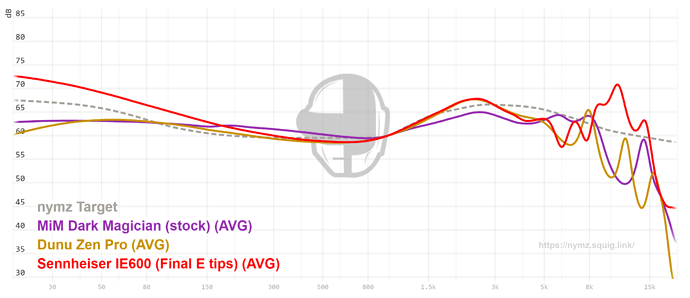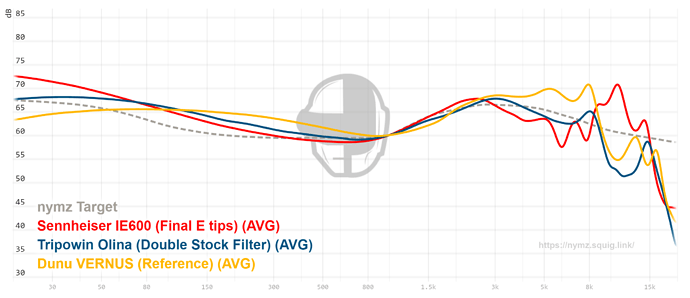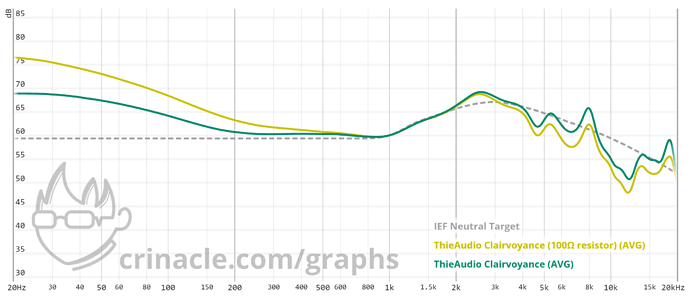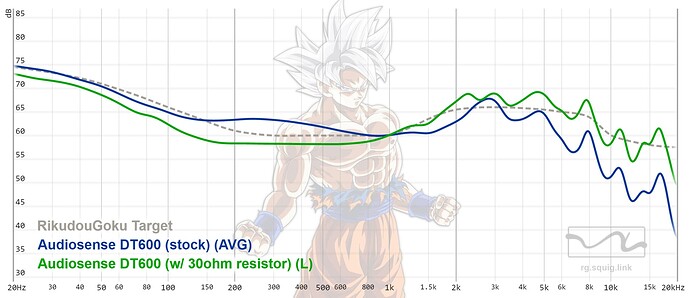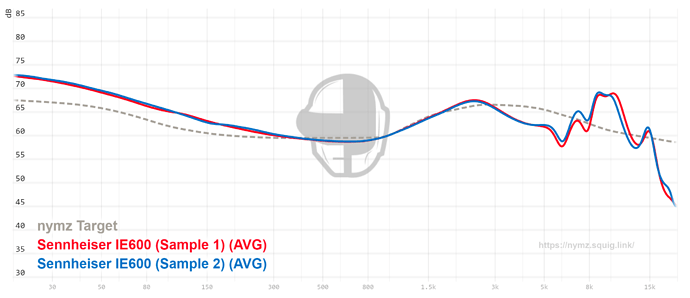No distortion. Use xbassII+xspace and fly away. Make sure to update the firmware!
I wouldn’t say tea2 is less boring than OG tea: the OG set has a less conventional signature than tea2, this is, in a way, less boring.
One thing I noticed on OG tea: I listen to it much louder than other sets. I don’t feel limited by the treble, and at the same time I feel the need to up the volume to get more details. I hope I won’t damage my ears…
I may agree and may be why I am letting mine go. I do find it better on the Quedelix with Crinnacles eq for it. I am enjoying the Airship quite a bit and as always the Timeless.
Sennheiser IE600: When detail meets fun
This review was originally posted on Head-Fi as part of the tour. You can find it here in case you prefer to read it there or their layout.
Pros:
+Detail level for a single DD
+Bass is always fun
+Lower treble dip is tastefully done
+Comfort
+Mids are still good, despite the tuning
Cons:
-Needs tip rolling
-Fatinding due to treble and bass elevation
-Mids are recessed
-Stage
-Fit might be funky to some people
Disclaimer: This unit was sent directly to me by Sennheiser and it is part of two tours arranged by themselves, one in Europe and one in the U.S. This unit will be sent back to Sennheiser after my assessment to be sanitized and sent to the next person in line. Sennheiser asked for nothing else but a full review and opinions, without giving any incentives or influence over them, so as always, what you are about to read are my own thoughts and opinions. Thanks once again to the Sennheiser team for giving me this opportunity.
Prologue
Sennheiser needs no introduction. The German based company has proven over the test of time why they are considered one of the top dogs at the game - their full-size headphones are some of the most recommended and acclaimed pairs all over the internet (I still haven’t heard any, so shame on you nymz, what a joke).
Last year, during the summer, the world skipped a beat, as two single-DD IEMs were announced: the now (in)famous IE300 and IE900. Sennheiser’s plan was simple: take a shot at the fabled tale of great top-tier DDs with the 900, while giving the crowd a more budget approach to taste it.
To my sadness, I never had a chance to try any of these, as only the IE900 appealed to me, but the hefty price tag did not, as it’s still $1500 for a single dynamic driver IEM. Those who had a chance to try them, mainly complained about the relatively recessed pinna gain, affecting the mid-range of the replay, while others grabbed their tinfoil hats and started speculating how there would probably be another release between the 300 and the 900 later down the road. Half a year later, the tinfoil hats were thrown into the air like students after graduation, and there was the announcement.
The Sennheiser IE600 is a 7mm single dynamic driver IEM kicking in at 700 USD, according to the official website. Following the same form factor as the other 2 predecessors and with a 3D printed shell made of a special metal, the footprint is small and the weight is marginal.
Is it the fabled high-end DD everyone is looking for? Let’s find out together!
Non-sound characteristics
Inside the box
- 3.5mm (single ended) MMCX cable;
- 4.4mm (balanced) MMCX cable;
- 3 pairs of silicone tips with tuning foams inside;
- 3 pairs of foam tips with tuning foams inside;
- Carrying pouch;
- Manuals and warranty;
- Cleaning tool;
- Shirt clip.
Fit, comfort and source pairing
Before we delve into what really matters, I would just like to touch on some important non-sound aspects.
First one would be the fit. At first I had it and then I guessed it was related to the small form factor, but then I quickly realized it wasn’t - the fit on these is heavily tip dependent.
With stock tips, I was having problems even just having a seal. I panicked at first, as these tips have tuning foams inside it - a last line touch of tuning that Sennheiser uses to achieve the intended sound.
As you might guess, this was a major concern to me because, if I am having fit and seal problems when I move around and I need to change tips, that will affect the tuning, right?
Long story short, not by much (please see the graph below, in the sound section regarding this difference). In fact, after tip rolling and ending up using Final E (large size) tips, getting a better seal opened up the sound even more, giving me a sense of a more controlled mids and upper treble, with more impactful bass, and as of that, the following impressions are not based on stock tips but using Final E tips. If you end up buying this, beware, as you might need to tip roll a lot.
As for isolation, I would consider them on the average or slightly above average, depending on the size of your ears. The small form factor is brilliant for people with smaller ears or canals, as they fit really deep and not shallow. For people with larger ears, you might have more problems regarding fit or isolation.
Another word must be thrown into the pot, mentioning the stock cable. I must confess I did not try any other aftermarket cables with the IE600, and all these impressions were done stock.
Both provided cables are the same, only the termination changes and they connect to the monitors using MMCX standard connectors. The important thing to note about the stock cables is that they include moldable earhooks, which is unusual and only the second time I have used it (first one was Sony EX800ST). Keep in mind these are meant to be adjusted/tailored to your own ears, so play around with them, as I feel they are very important to help with the fit and comfort, as you can shape them how you please and together with the MMCX 360º rotation, they should fit your ears like they need to.
With the stock cable and the carrying pouch (that I love by the way, as it is simple and small), the IE600 turns into an ultimate grab and go IEM, as you just slide it in your pocket.
Given all the above, I feel I need to sprinkle all the gold dust right now and say that the Sennheiser IE600 is one of the most comfortable IEMs I have used, despite not being the best fit ever, and that plays a big role in my daily life as I am always using something on my ears, but keep in mind your mileage may vary, as every ears are different.
The nitpick I will leave is regarding MMCX connectors, as I am a public and vocal disliker of the system, but in this case it works for the best. My word to anyone using MMCX connectors is to choose a cable and stick with it, as these connectors start to get loose with time and/or if you cable roll a lot.
As for driveability, I would say they are on the average side of things. They require some power but most used sources in the market should suffice, including the usual dongles. Bluetooth DAC/AMPs like Qudelix5k shall suffice very well, as I’ve tested that as well one of the times I was shopping for groceries.
I am a source enthusiast, so what I am about to say should be taken with a grain of salt and keeping in mind YMMV: I think the Sennheiser IE600 scales a little bit with power and pairs better with slightly warmer or more analog sources.
I found the best results to be achieved with Class-A amps (Singxer SA-1, Hiby R5 Gen2), the more analog warmer sources like the iFi xDSD Gryphon or the more neutral and technical (Cayin N3Pro on Solid State). I also did extensive tests with the Topping E30+L30 stack, and it worked great as well, giving an edge on the treble and detail.
A last word on Gryphon, as I really enjoy the combo with the IE600: for bassheads you can just turn on the magical XbassII button to help you with that. I would recommend also using the presence switch to give both bass and upper mids, as it balances out the natural V-shape of the monitor. Xspace also works wonders for the presentation, although it will leave out the more natural or intimate feel of it.
Enough rambling, let’s talk sound, shall we?
Sound Characteristics
The Tonality
Right out of the gates, I would summarize the Sennheiser tastefully done V-Shape. Just by looking at its graph, it’s pretty obvious what was the objective traced for the monitors: A prominent bass and upper treble elevation, with just enough pinna gain for the mids to not feel that much recessed. Depending on each’s own personal neutrality, some folks might even consider this more of a U-Shape than a V-Shaped IEM.
On my first impressions of this set, I shook things a little and started by the higher frequencies, but now I will serve you the course meal first, the start of the show and the reason most will fall in love with it - the bass.
In a word? Gooooooood. Tracks like “Why So Serious?” prove just that, just like the treble, bass extension is one of the show stoppers. At around 3 minutes and 26 seconds, the world will just rumble at your feet - funny fact, it happened to me while picking groceries.
Another proof of the lower end is the musical classic Angel by Massive Attack. This track’s intro also helps to explain how the tuning has emphasis on the sub-bass over the mid counterpart, by showing its rumble and going down low.
While listening to “Playing God” by Polyphia, all enphasized aspects come alive. The level of treble presence and detail bring a new level of micro-details to the song, while the bass drop around the 28 seconds just feels authoritative. Both are a bit on the overemphasized territory in comparison to the mid-range, but still leave out a clinical taste on your lips, without bleeds whatsoever.
Despite the mountain of elevation in the low end, the mid-bass is impactful but clean. It isn’t really a real Slam Jam party as some will expect from the graph, but it pushes some air together with the elevation, and you can bet you will feel it, while not overshadowing the track, at least not as much as the treble or the sub-bass. The pedal played by Elise Trouw on her live loop of “How To Get What You Want” is a nice proof of that, and correctly balanced with her voice, while still showing its authority.
Speaking of vocals, let’s quickly transition into the mid-range, or as expected, the weakest link. I will be honest, I was expecting much worse mids, and way more recessed. They are a bit recessed, but still just south of neutral to my ears. I still find the need to increase the volume a bit as I am a mid-head and on very balanced tracks like the famous version of MTV Unplugged’s “Hotel California”, where Eagles performance needs a touch more mids in comparison to the treble sparkles and the monotonous bass punch. Despite not being as balanced, it was one of my favorite replays of the track so far, so touché.
Given the ultra transparency of this mid-range, pianos sound great and very detailed, just like Hania Rani - Glass can show us - all the wood sounds are there, and just right and well separated, without a blur.
Vocals are, in my opinion, the IE600’s weakest link, but despite not being anything to write home about, they are very far from bad. They are transparent, clinical and very detailed. I still sometimes miss my Softears RSV’s organic presentation, that just fits me better in this regard, but you can’t have the cake and eat it at the same time. Again, for those that prefer neutral mids or vocals, this won’t be a much of a problem, as the micro details and the cracking on voices are just on point - a good example of this would be the Sway version by Diana Krall, where you can feel hear all her lip touches or vocal textures.
What was less expected to me is the fact that the female vocals sound better than male do, having more bite but without ever going into the shout territory whatsoever (Adele - Oh My God and Lykke Li - Silent My Song). Michael Bublé’s performance on “Feeling Good” gives a slight feeling of something missing, maybe some weight and presence that is, again, south of neutral.
If we keep climbing into the frequency range, we finally reach the other headline: the treble.
I think I can’t mention IE600’s treble frequencies without mentioning some of its technicalities: The amount of clarity and sheer detail you get thrown at, for a single DD, it’s impactful and deserves respect. Sennheiser did it and IE600 is the most technical single DD I have experienced to date, and I knew it in the first 30 seconds of my take.It’s actually pretty obvious how they are achieving this - besides all the work inside the shell and the driver itself, - if you look at the mid to upper treble region.
I’ve been extra kinda so time to cut the candy talk and rip another band-aid: These will be too hot for some people and/or music genres.
As an upper mids/lower treble sensitive person and fond of darker sets, the fact of me liking this level of elevation in the treble region surprised even myself. After further looking in the FR graph above, I would attribute this to the dip from the upper mids into the lower treble, a region where it makes or breaks an IEM for me, and holy moly did they get it right.
Cymbal strikes and electric guitars still sound great and natural, despite the dip. Lust For Life by Iggy Pop or the Larnel Lewis’s drum solo on Change Your Mind prove just that, along with Jason Richardson -Titan that also shows this contrast on more busy passages.
The boosted region above 8k hertz, it’s tiring for long sessions, and the first thing that came to my mind was the UM Mest brothers, who instantly overloaded me with too much detail, which I appreciate, just not the usual hours I listen to music everyday. Despite this fact, I respect the hustle, as it was cleverly done in my opinion.
Everywhere by Fleetwood Mac shuffled and here I am, mesmerized by how the intro of this song could describe this set’s upper treble: a beautiful bunch of stardust flying around, that can be too much for some, but beautiful nonetheless.
Technicalities
Sennheiser quality is undeniable, but let’s be realistic here, no one will be paying IE600 price just for tuning itself, as I’m still a preacher that tuning is free.
So, how are the technicalities of the set? In sum, a fallacy of composition - The whole comes out as great, as some of the weakest characteristics get blended in by the others, resulting in a better outcome.
Time to rip the band aid off, once again: the stage and imaging. Soundstage is size is modest and in some tracks it may be too close to your head or intimate, showing that it could use more depth and even width.
The stage height (Agnes Obel - Curse) is above average, but could still use a bit more extension, placing it well above the pack. Following the trend, its imaging (Yosi Horikawa - Crossing), sounds great on positional queues, despite not always being able to perfectly do the center imaging when compared to top dog’s like the 64A Trió.
The stage’s holographic presentation kicks in and is very well done, precise to be exact, when the track demands it (Yosi Horikawa - Bubbles), which is something I really value.
So how do these presentation flaws get masked, as mentioned above? For starters, the sheer detail is excellent, giving you a sense of micro and macro queues everywhere. Following the line, comes the dynamics of the driver, which are clearly up there with a fast tight response and sharp transients.
To close the winning formula, comes its timbre, something that I’ve been taking into consideration more and more nowadays with the instrumental part of my library, that despite not being the best in class, is up there, despite all the treble elevation that sometimes masks it or gives a metallic shrill on the brass instruments notes decay tail. In all, I would say the attack and the decay are pretty much in sync, neither too fast nor too slow (David Carroll - Hell’s Bells).
Music
As part of the Sennheiser tour, the reviewers were kindly asked to share some tracks that highlight the IE600, which I am always glad to oblige - always remember that music is the reason why we do all of this, not the gear. Instead of just dumping a bunch of electronic songs, I tried to fit some different genres in, to cover more angles and let people make more educated decisions. I will also leave some albums I listened to fully and I think the Sennheiser set did a great replay of.
Tracks:
- O’Flynn - Tyrion
- Jay Cosmic - The Tunnel
- Hans Zimmer - Why So Serious?
- Hyper - Spoiled
- DARKSIDE - A1
- Rameses B - Sonder
- Vanilla - Azure
- State Azure - Mirror Infinite
- Jungle - The Heat (Joy Orbison Remix)
- Marco Carola - Play It Loud!
- Trentemoller - Chameleon
- Sawano - aLIEz
- Ten Walls - Walking with Elephants
- Chris Lake - Free Your Body
- The Prodigy - Thunder
- Unlike Pluto - Everything Black
- Flume - Insane
- EVERGLOW - DUN DUN
- Billie Eilish - Oxytocin
- Dnmo - Broken
- Tyler the Creator - EARFQUAKE
Albums:
- TiMO ODV - Origins (EP) (Tidal)
- Moderat - Moderat (Tidal)
- Kölsch - 1977 (Tidal)
- Paul Kalkbrenner - Parts of Life (Tidal)
- The Blaze - Territory (Tidal)
- Armin Van Buuren - Imagine (Tidal)
- Worakls - Orchestra (Tidal)
- Hans Zimmer - Dune (Tidal)
- Kindness - House (Tidal)
- Massive Attack - Mezzanine (Tidal)
- Ludwig Goransson - The Mandalorian: Chapter 1 (Tidal)
Comparisons
The top dogs
I will now compare directly and talk about how I expected this set to rival my other single DDs like the Dark Magician and Zen Pro but (spoiler alert), I came to the conclusion they are all different sizes of the same tool, with the application and strong suits being library dependent.
I decided to highlight their worst and best features as some people who are considering one of them, will maybe also consider the other ones or they wanna compliment their DD collection.
Non-sound Characteristics
Sennheiser IE600
IE600 has the worst fit of the three with average isolation, being very comfortable nonetheless due to weight and shell material/shape. It needs the most power/volume to achieve clean and audible mids in comparison. The accessories are very good and a great package overall. Stock cable is fine, but earhooks might be a deal breaker for some. It is priced in the middle of the other two and it’s the lightest of the three.
DUNU Zen Pro
Zen Pro is the most expensive IEM of this comparison, too close to the kilobuck region ($900). Is by far the easiest to drive, which also translates into a problem as it is very/too sensitive, hissing on most powerful sources of the market. Between the three it has, hands down, the best accessories, build quality and fit. Due to its semi-open back design, it also has the worst isolation of the pack. Being an all metal shell, Zen Pro is also the heaviest.
MiM Dark Magician
The DM is by far the cheapest, at around $600. It is a DIY IEM and the production was limited and even hard to get your hands on one. Nowadays, it got discontinued and you can no longer find it, as it got replaced by a new version that doesn’t sound or graph the same. Due to this, it has the worst accessories (only comes inside a circular metal box with some tips). Stock cable is good and looks great, but the earhooks need some slight adjustment for the fit. It has by far the best isolation when compared to the two IEMs above. Comfort is great and they are very light weight, almost like a father, for something that is made of metal.
Sound Characteristics
All the comparisions you are about to read were done using the same source, the same plug (4.4mm balanced) and one of my test playlists (Tidal). I decided to add the following spider graph to be better visualized:
Sennheiser IE600
The IE600 has the most prominent bass and treble, which makes it the only V-Shape of this shootout. If you are looking for the most “fun” or energetic of the three, this is it. Nothing in this life is for free, as that much energy will come out as the most fatiguing of the pack - I would describe it as the one of the shorter sessions, best suited for electronic music.
Despite being the only one with recessed mids, this is just slight, and the upper mids/lower treble is very well done, on par with the Zen Pro, but coming out with the worst vocal presentation of the shootout. Stage size is the weakest point, as seen above in this review, but the imaging is good and it’s the most resolving IEM in this single dynamic comparison, giving a high sense of macro details and clarity, having the best extension on both poles.
DUNU Zen Pro
The Zen Pro is the instrumental beast. Paired with a balanced tuning, its timbre, driver speed and dynamics turn it into a technical beast. I would consider it a neutral with a slight bass boost and let me tell you, what a bass. It is the best bass quality and texture of the pack, together with a great sense of impact and its speed, putting it ahead of the others for people who prefer these characteristics.
One of the things that I immediately noticed was the sense of separation and layering it provides, but it lacks stage depth, despite having the best imaging of the three. The rest of the stage is above average, slightly holographic, and all this pretty much thanks to its open back design that comes out as a con for outdoor usage.
The micro details are good and have some sense of clarity, but not everything is all sun and butterflies, as the tuning is rolled off in both spectrums, and it’s slightly noticeable - despite not affecting my library as much. Another point against and that needs to be noted is that the upper regions timbre can get slightly off, especially with ultra bright sources, giving a sense of metallic taste. In my experience, it really shines with more analog sources like the Cayin RU-6 R2R dongle.
I would consider it best suited for instrumental/orchestral/jazz/classical libraries. It can get physical fatiguing after some hours of usage due to its weight and I would consider it good for medium sessions.
MiM Dark Magician
The DM has the most balanced tuning of the three - it is the real smooth operator. You can throw what you want to it, it will change like a chameleon and replay accordingly. Given its isolation and being less fatiguing than the others, I consider it can be used for ultra extensive listening sessions, for most libraries and anywhere.
Despite the semi-flat graph, don’t let it fool you, everything will show up when it needs to. The bass is the weakest of the 3 in terms of dynamics and texture, but it has very nice micro details all across the spectrum. Another point against the DM is that the imaging is slightly weaker than the other two.
Now, where it really shines is on stage presentation, containing the biggest and most holographic of the three, and having the best, or at least on pair with the Zen Pro, left/right pans.
Despite the good micro details, the overall clarity is very good but falls behind the other two, making it the least resolving one of this shootout. This fact is pretty much attributed to having the least amount of treble, which comes out as way less fatiguing and the best volume scaling by a mile.
The mids are borderline perfect and a true masterclass, making it the best vocal replays of the three. The frequency extension falls a hair shorter than the IE600, but above the Zen Pro.
The underdogs
I decided to add this chapter, as a last minute call, as I’ve read somewhere people complaining about reviews only comparing IEMs on the same bracket. This got me thinking and I decided to add a very short comment on how the Sennheiser IE600 compares to cheaper competitors in the single DD world. As we all know, the diminishing returns are pretty real so we will keep an eye on that.
Tripowin Olina (double stock filter)
My default single DD recommendation had to be included. For $100, Olina has been a tough bone to chew on.
While Olina features a Harman tuning, compared to the IE600 it comes out as less energetic. This also translates into a better midrange presentation by the Tripowin offer, paired with a better stage size and more holographic. The mid-bass is more prominent as well which makes it more impactful than Sennheiser’s.
Other than the points above, the IE600 is a much superior IEM in every front, especially on the technical side of things and the extensions. Despite costing 7 times more, it doesn’t not have 7 times the performance, but you are paying the premium for that last push.
If you are looking for an endgame V-shaped version of the Olina, the IE600 might be for you, as long as you are fine with the tradeoffs.
Dunu VERNUS (Reference Nozzle)
VERNUS, being a special and limited edition of the Falcon Pro, comes out as a neutral with a warm tilt, all across the lower frequencies. Opposite from the Olina, the biggest difference is in the bass, where the IE600 blows up the barrel and the VERNUS is shy. Combining that low elevation with a bigger elevation in the treble region, they feel like opposites, and filling different genres/libraries.
Same as Olina, the price difference won’t show the performance difference. However, if you feel you love VERNUS but want that XBass button on the go with better techs, the Sennheiser IE600 will suit you.
Tanchjim Hana 2021
I don’t have the Hana with me, so this will be a “from memory” thing, so take it with a giant grain of salt. If you really enjoy Hana’s signature, that mild V-shape, and want a technical upgrade, I feel the Sennheiser IE600 is your call.
The Verdict
I might paraphrase once again the above review, but I really feel I am now in position to say that IE600 is the most resolving single dynamic driver I have experienced to date, and for that, it already comes out as a winner.
Again, every set has its flaws and Sennheiser or not, this is no exception. I feel this set won’t work with every ear and every preference, and some will find it tiring after long periods of time. This won’t be a mid-heavy set, and I found it to work much better with the electronic side of my library, like techno and house, than it did with the more relaxed tracks. It won’t have the most accurate replay of a song, due to its bass and treble boost, but it sure will add a lot of fun to the replay.
To quickly answer the question I will be asked the most after reading this: Yes, I think IE600 is worth the price when compared to other sets in the market, for my tastes and library. Now, if spending hundreds on a single DD IEM is worth it, that’s up for you to decide.
If you are looking for a higher-end single DD, I hope this review helped you have a clearer view of which one to get. As long as you make an educated decision, I don’t think you can go wrong with this set.
I am very happy to recommend the Sennheiser IE600 to anyone that is looking for a fun and energetic single dynamic, especially a V-Shaped one that can also bring the resolving power to the table and challenge other types of driver setups.
As for me, I can’t wait for the future releases of single DDs and especially from Sennheiser. Good job!
Value Rating: 4.5 out of 5. Personal ranking: 8,7 out of 10.
Thanks for reading!
@ZeosPantera going deeper into the Tea Cult after the Tea2 praise. Now the Zen Pros. And declined a colab of it to not change its tuning.
Touché. I salute you. ![]()
Just picked up a pair of EJ07 OGs on Head-Fi and sold my Variations.
I’m way deep in the Tea cult now but loving the journey.
Very nice find congrats and enjoy!
Congratz ![]()
![]()
Hope you enjoy it! Welcome to the Cult ![]()
After 41 days in the Tea Cult, I am still very content with the OG Mangird Tea. I am sort of shocked after chasing gear for most of the last year, I think the trio of Tea, Olina, ad S12 has me in a very happy place with my IEMs.
I might be ready for something a bit more on the source side. I use a BTR5 most of the time. Portable has advantages, because I do work out of a laptop bag at least a day or two per week. I have been pondering something like the Hilidac Audirect Beam 3 Plus, or an iFi Go Blu but am wondering if there is some other portable that is life altering, that isn’t in the Gryphon price range.
I know that @nymz was pretty nuts about the Topping NX7 for the money, and I was thinking if I did that I could use the BTR5 or the Periodic Rhodium Dongle that I already have. It is pretty large, and I do prefer having the option to do Bluetooth, but the BTR5 solves for that.
Post title - too deaf to be an audiophile
@nymz how are you liking your new setup L30/E30 and SA-X1 for IEMs?
As my story with buying IEMs is more or less finished as I found my endgame I tried to find another rabbit hole and started looking into sources ![]()
Today I set up DX3Pro+ at the office for source for speakers and IEMs.
After some A/Bing my conclusion was that I have not heard any immediate difference to my motherboard Realtek audio card with both speakers and MESTs. I have quite good workstation though, that may be one of the best not dedicated audio DACs out there, but still.
Then switched to Q5k as a source - no immediate sound difference between DAC/AMP and straight out of the 3.5 mm plug to both IEMs and speakers.
The sound in all those 3 sources was precise and clean, I would not want anything “more” from that, but I still expected to hear something “extra” with such a good and pricy (as compared to 0 cost of having none) device as that Topping is.
I don’t know, maybe I am too deaf for anything like that. The only one I could hear the difference listening to is when I plugged in CX31993 dongle DAC for a while - the sound is generally very “grainy” and low-res as compared to all of the ones above.
In the meantime I am waiting for the delivery for Questyle M15 (which is supposed to be technical king) early next week for the ultimate test whether it even makes sense to try anything better (as I like it enough).
In the end some final notes on Topping’s usability in general:
- generally DX3pro+ is very cool, small, well-built device - probably all that anyone would ever need spec and function wise for desktop (especially when using full-size headphones). See Asterix in next point
- there were rumours that it is not suited for IEMs due to power clipping at low impedance values (<16dB). On low gain (+6dB) I have still plenty of headroom (-30-40dB) for anything low impedance I threw at it (Mest, S12), so in my opinion it is completely feasible for anything apart from maybe something really crazy with 5-8Ohm impedance like Volume or T800. For IEM I would rather have something portable (DAP/dongle) I think
- not having a mic input/TRRS 3.5mm jack in audiocard is terrible for work usage as I need to switch audio device from settings to standard MOBO jack and earphones w/ in-line mic in Windows anytime I have a meeting and then back. It is probably a standard in desktop audio solution, but hip dac for example (as portable device) had TRRS, so it did work without any hassle.
- not having automatic headphone detection while in DAC mode (feeding speakers in most cases) is terrible design choice. What is really the use scenario you want your DAC feeding something while having headphones on? Being DJ maybe. It would make a little bit sense if the RCA outputs level would be set in stone at least, not adjustable with pot. Now I have some -dB level set for speakers which is not aligned with my requirements for earphone, so either it would blow my ear or I need to adjust the setting.
- clicky-clacky Topping potentiometer is cool, though it misses some steps from time to time. Having set step levels in minus dB is great, I can remember one setting and get there whenever needed. Analog pots are cool, but not as usable in my opinion, having imbalance in low settings and looking for a perfect spot every single time you powerup etc
For this I actually bought a Deity D4 Mini mic, and use it on a cheap stand, and have it plugged into USB 3.5mm adapter that gives me a bit more cable for reach. It has decent sound quality, is cardioid ( directional ) and has both cables. I think with the mic, stand, and adapter I am at about $70 total.
I then plug the USB into a hub on the desk, which that goes into the machine I am using, but I use the same desk for a couple different laptop machines.
That whole post remindes me of this video: Headphone amps might not matter - YouTube
I had the same experience years ago, when I demoed Sennheiser HD800 and Beyerdynamic T1 with >=1k Euro dedicated headphone amps vs my 200 Euro soundcard and couldn’t make any difference.
With the Mest MK2 it’s different though. I do hear a difference, but from all my testing it boils down to output impedance for me… nothing else it seems.
That is funny, I was just thinking that Dan had posted a video on that topic, only to see your post.
I always wondered if the AAC encoding on his video is part of the issue, but I know he has owns some very good headphones and IEMs, so his in the room experience wouldn’t reflect the encoding.
Funny that you say that, because I have run my headphones with extra impedance just to change the sound.
I think often (not always) when you hear people say that even IEMs need a powerful source, they often mean “a source meant for big headphones” and in extension “a source not optimized for IEMs” and therefore “a source with high(er) output impedance”.
Technically speaking my understanding and experience is that IEMs often sound cleaner on lower impedance, but I often hear people (like you) liking the effect of higher impedance subjectively better.
Some respond very well to additional impedance. (not single DDs though, due to their flat impedance response.)
This is exactly the video I had in mind after some time off the test. Now it starts to make sense to have a source which is clearly distorted (like lamp) on top of those clean (like topping) instead of having multiple clean ones, at least in my opinion.
Dan was hated by some people because of conclusions from his video, because the topic is controversial (especially if you spent 1k $ on setup just to hear someone says it sounds the same as 100$ one) ![]()
I love this guy’s content
I think that impedance is not the only defining factor for IEMs, but there is this Power and THD rating at different load impedance for any amp that may often be overlooked. There is always this parameter for amps what headphone impedance it fits and the lower limit is just what we need to know for earphones. In that range the power output vs. impedance and distortion should be somewhat linear, below that - not necessarily as we get some swings in the power delivered affecting the FR - especially with multi BA sets which are also non-linear for its impedance at different frequencies.
Very cool, much more smart than me article on that topic from ifI. Their FAQ is generally very nice read ![]()
I have a dx3 pro v2 (si previous version of your gear), and agree 100%.
The clicky pot is great for accuracy, but the feeling gets on my nerve now. I think I would prefer a smooth digital pot like the zen dac’s much more.
The lack of mic-in for any decent dac/amp except the schiit fulla is a huge missed opportunity for manufacturers.
there are some others that have mic passthrough but very niche market (Burson used to make one but discontinued now, mayflower makes a couple), most people just use desktop mics
